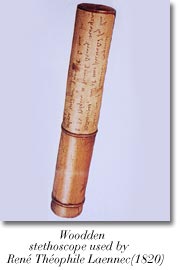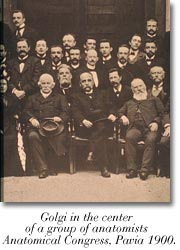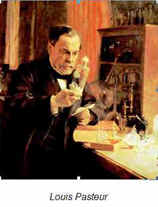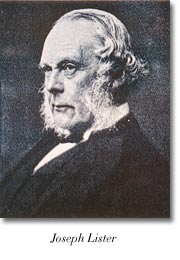|
|
|
|
Lesson 7 |
First part of the 19th century. Semeiotics, Sanitary assistance, Cell Pathology, and Microbiology. |
|
|
|
|
|
|
|
By the start of 18th century all durations of semiotic processes were known: observation, palpatation, percussion and auscultation. Laennec, who later died of phthisis (consumption), made many important contributions to the definition of many pulmonary diseases, pneumonia, tuberculosis which he rightly recognised as a single disease, while, before him, its various forms and localisations were regarded as separate entities. The importance of the stethoscope's contribution arose from the fact that it was not possible to listen with the ear on the chest of a woman. It was actually unthinkable that a man could place his ear in contact with a woman's chest and the instrument served above all to avoid this.
Apart from sepsis (septic poisoning) caused by operating with bare hands, among the most important problems of surgery was the fact that anaesthetics did not exist. Several people discovered it in America, including Horace Wells (1815-1848) and William Green Morton (1819-1868). In America recreational use was made of ether during holidays and people, under the influence of the ether, noticed that they no longer felt pain. This was immediately used during dental extraction. Following this, there was a endless dispute about who had discovered it first, and although a prize was put up, it was never collected. Besides ether, nitrous oxide and chloroform came into use. Anaesthesia with chloroform was administered to Queen Victoria by John Snow (1813-1858) during her delivery of Prince Leopold. In this period (1859) came the appearance of the first sanitary institutions, the very first of these being the Red Cross. It was founded because of an episode during the course of the Battle of Solferino. There was a rich Swiss financier, Henry Dunant (1828-1910), who had mining interests in Algeria. In order to obtain a concession he had to confer directly in person with Emperor Napoleon III who was at the battleground, so Dunant went to Solferino. Although he was not able to speak with the Emperor, he was so struck by the way in which the wounded were left on the battleground that he experienced a kind of epiphany. He abandoned all of his other activities in order to dedicate himself to this problem and, through great sacrifice (he became impoverished), he managed to persuade the governments to inaugurate this neutral association, which was called the Red Cross in honour of Switzerland - the flag of the Red Cross is the inversion of the Swiss flag. There was a worldwide Congress in which the neutrality of this organisation was sanctified, therefore meaning that the wounded could be evacuated from the battlefield and treated. After the Red Cross, the Red Crescent was founded for Islamic countries. It was a great step forward for humanity.
In the early 19th century sanitary police measures became efficient: quarantine and exchange of goods were regulated in a more serious manner. In France in 1800, before Laennec, Marie Francois Xavier Bichat (1771-1802) criticised the microscope in that this instrument was absolutely useless, as indeed it had been up to that point. He said it was necessary to return to ancient times, that is to say, to using artificial methods, such as boiling (as Malpighi had done) in order to discover the body's fundamental components, which according to him were the tissues. On boiling the tongue he managed to peel it and noted the papillae under the epithelium and that it was possible to decompose the organ into layers: the tissues. Because he said that lesions were to be found, not in organs, but in the tissues, he went to a finer level than Morgagni had. It is a curious fact that Bichat, who negated the use of the microscope, coined the term histology. Later on (1838) Mathias Schleiden (1804-1881), demonstrated that vegetable organisms are formed of cells, and the same (1839) was confirmed for animals by Theodor Schwann (1810-1882). In 1858 Rudolph Virchow (1821-1902) noted that the lesions of the diseases could be found in cells and so published his famous treatise "The cellular pathology". He was the founder of histopathology, which today still is the basis of diagnosis; inter alia he was the fist to coine the terms and to describe: leukaemia, leukocytosis, neuroglia, thrombosis and amyloid, and this was all in addition to being a great anthropologist. In fact, Virchow was the person who demonstrated that races do not exist in humans, thus negating the existence of a distinctive German race; for which, Hitler never forgave him. He was a left-wing politician, and applied himself to improving the hygiene conditions of miners and was the promoter of the construction of the sewer system of Berlin. All the same, he also made some mistakes: for many years he refused to believe in the doctrine of contagion through germs formulated by Pasteur and Koch. Other important discoveries were the theory of evolution by Charles Darwin (1809-1882) and the laws of genetics discovered about 1870 by Gregor Mendel (1822-1884). The latter laws were initially ignored, and then rediscovered 30 years later by Hugo de Vries (1848-1935). Another consequence of the cell theory was the use of colorants to demonstrate the lesions which Virchow had managed to demonstrate in part because he, at first, only had carmine available to him. A short time later other colorants were introduced such as haematoxylin-eosine and they were added to tissue preparation techniques: microtome, paraffin embedding, etc. However, there were great problems in regard to the nervous system. This was almost impossible to study because only the nucleus could be seen with the methods in use, as well as part of the cytoplasm, but not the cellular processes without which it was impossible to obtain an idea of neuroatonomy.
Preparations stained with silver and observed under the microscope seemed to show that nervous processes were connected by a network of processes. Thus, Golgi maintained that the neurons were not separate entities but connected in a network of processes. By contrast, Cajal extrapolated the concept of the cell as an independent unit to neurons, and it was he who made formidable contributions to neuroanatomy. Cajal was from Spain, a country which, at that time and in the previous decades, was marginal to international science, Golgi, instead, came from Pavia, a city which had been under Austrian rule until 1860. This meant that all scientific contributions made in the University of Pavia till when the city and Lombardy were part of the Austrian Empire, were translated into German and diffused throughout central Europe. At the end of the Austrian rule, Lombardy, once again, became a provincial country and so Golgi's discoveries were little recognised abroad. On the other hand, Cajal spread his discoveries by going to congresses, and by speaking and writing in French and German. In 1906 he and Golgi were jointly awarded the Nobel prize. Besides those on neuroanatomy, Golgi made notable contributions to the study of the pathology of malaria. He deduced the connection between the appearance of the fever and the discharge of the parasite from the red blood corpuscles. Little progress was made on contagious diseases; the infant mortality rate of women in labour in hospitals with doctors and students was high, but was lower for women giving birth at home or in hospital departments maintained by midwives. The assistant professor at a clinic in Vienna, Ignac Fulop Semmelweiss (1818-1865), was struck by this phenomenon and thought that the doctors and the students of medicine were the ones responsible because they palpated the intimate areas of women without gloves, passing disease from one to another. Above all, hygiene was generally poor in hospitals where the sheets were only changed once a month. Semmelweiss (1847) insisted that doctors and students washed their hands with calcium chloride between visits. He was a difficult character and felt so psychologically persecuted that he had to be committed to a lunatic asylum. Later on, when hospital hygiene became widespread, he was given credit for being prophetic. At the beginning of the second half of the 19th century the idea of contagion was still unknown: surgery was carried out with bare hands, ignoring hygiene, but thanks to Louis Pasteur (1822-1895) this ended.
Another great microbiologist was Robert Koch (1843-1910), Nobel prize winner in 1905, A country physician, became interested in bacteria when his wife gave him a microscope for his twenty-eighth birthday. He isolated the bacillum anthracis, developed o called methods for producing pure cultures and introduced agar. He proposed the four criteria (Koch's postulates) to ascertain that a germ really is responsible for a particular disease. In 1882 he discovered the bacillus responsible for tuberculosis and thought that he had discovered a therapy based on tuberculin. However, it was a grave error because this substance is only of value in diagnosis, having no therapeutic value at all. Then in 1884 he discovered the vibrion responsible for cholera as described twenty years beforehand by Filippo Pacini, inspired by Agostino Bassi.
The so called germ theory of contagion based on the discoveries by Pasteur, Koch, Emil von Behring (1854-1917), Shibasaburo Kitasato (1852-1931), Almroth Edward Wright (1861-1941) and many others, had a momentous influence, especially in the Western world, on the everyday life and even on economy. It is due to the fear of contagion that women abandoned the multiple petticoats and the long garments of Victorian era, and that men shaved their faces. The development of the modern industry of sanitary equipment for houses, of chemical disinfectants, and that of disposables such as toilet paper, sanitary napkins, paper cups etc., also was a consequence of it. |
|
|
From the notes of Alessio Orrų |
 Laennec was a student of Corvisart (Napoleon's doctor), and had the idea of making a tube which he called a stethoscope. In turn this became the precursor of the modern phonendoscope which allows the respiration and the heartbeat etc. to be heard.
Laennec was a student of Corvisart (Napoleon's doctor), and had the idea of making a tube which he called a stethoscope. In turn this became the precursor of the modern phonendoscope which allows the respiration and the heartbeat etc. to be heard.  Manuel Garcia (1805-1906) was a tenor who invented the laryngoscope in order to inspect the status of his vocal chords. In this period the oesophagoscope was invented. A doctor saw a sword swallower which gave him the idea of a light on the end a tube in order to see the oesophagus. It was illuminated from above by the flame of a candle, which was reflected in a small mirror which in turn allowed the inside of the oesophagus to be seen through a hollow tube.
Manuel Garcia (1805-1906) was a tenor who invented the laryngoscope in order to inspect the status of his vocal chords. In this period the oesophagoscope was invented. A doctor saw a sword swallower which gave him the idea of a light on the end a tube in order to see the oesophagus. It was illuminated from above by the flame of a candle, which was reflected in a small mirror which in turn allowed the inside of the oesophagus to be seen through a hollow tube.  Equally important was the work of Florence Nightingale (1820-1910). Before this, the idea of a paramedical body had not been conceived, and working in the hospitals were only persons of very low culture (servants, ex-prostitutes, and the incarcerated who were obliged to work in hospitals). It must also be said that this state affairs was peculiar to Protestant countries for, in Catholic nations, sanitary assistance was under the care of religious orders. This changed during the British expedition to the Crimea (1856), when Florence Nightingale, a lady belonging to the English aristocracy, insisted that a body of nurses be formed to follow the English army. She did this all practically at her own expense and the corps of nurses proved to be exceptionally important in assisting the patients. A terrible epidemic of cholera broke out, and these women excelled in curing the patients through, for example, putting hygiene measures into practice. On returning to Britain, they were highly praised and honoured. As a result, Nightingale created the first school for specialised nurses at St Thomas's Hospital.
Equally important was the work of Florence Nightingale (1820-1910). Before this, the idea of a paramedical body had not been conceived, and working in the hospitals were only persons of very low culture (servants, ex-prostitutes, and the incarcerated who were obliged to work in hospitals). It must also be said that this state affairs was peculiar to Protestant countries for, in Catholic nations, sanitary assistance was under the care of religious orders. This changed during the British expedition to the Crimea (1856), when Florence Nightingale, a lady belonging to the English aristocracy, insisted that a body of nurses be formed to follow the English army. She did this all practically at her own expense and the corps of nurses proved to be exceptionally important in assisting the patients. A terrible epidemic of cholera broke out, and these women excelled in curing the patients through, for example, putting hygiene measures into practice. On returning to Britain, they were highly praised and honoured. As a result, Nightingale created the first school for specialised nurses at St Thomas's Hospital.  The method for studying the nervous system (black reaction) was perfected by Camillo Golgi (1843-1926). Thanks to this method it was possible to see the cellular processes (Golgi's method used silver and so it is called the black reaction). An emulator of Golgi, Santiago Ramon y Cajal (1852-1934) put together several ideas and arrived at the concept of neurons as independent cellular entities. Formulated by His (1831-1904) and then by Sherrington (1857-1952), the concept of axons (neurites) as cellulifugal (in term of direction of the nerve impulse) processes and that of dendrites as cellulipetal ones, allowed Cajal to describe the first nervous pathway in the retina.
The method for studying the nervous system (black reaction) was perfected by Camillo Golgi (1843-1926). Thanks to this method it was possible to see the cellular processes (Golgi's method used silver and so it is called the black reaction). An emulator of Golgi, Santiago Ramon y Cajal (1852-1934) put together several ideas and arrived at the concept of neurons as independent cellular entities. Formulated by His (1831-1904) and then by Sherrington (1857-1952), the concept of axons (neurites) as cellulifugal (in term of direction of the nerve impulse) processes and that of dendrites as cellulipetal ones, allowed Cajal to describe the first nervous pathway in the retina.  He was an inorganic chemist employed by the French government to study the mechanisms of wine and beer fermentation, and he realised that fermentation took place because of the action of microorganisms called saccharomycetes. He developed a method of conserving foodstuffs with heat: pasteurization, which still is used today. He was also entrusted with checking the truthfulness of spontaneous generation and to investigate upon certain diseases of silkworms, such as pebrine, which he demonstrated to be caused by a protozoon. Basing his judgment on the ideas of Spallanzani and Bassi, he arrived at the conclusion that bacteria existed, which were germs responsible for diseases. Unfortunately, at forty-six years of age, he suffered from a stroke but this did not impede him in making his important discoveries. Moreover, he found a way to attenuate the germs through suitable treatments and he developed a series of extremely important vaccines (his own term coined in honour of Jenner) such as the vaccine to immunize animals against anthrax as well as the vaccine against rabies. The whole world was enthusiastic about this last discovery when Pasteur vaccinated the shepherd boy Meister with success, as well as several Russian peasants sent to him by the Czar.
He was an inorganic chemist employed by the French government to study the mechanisms of wine and beer fermentation, and he realised that fermentation took place because of the action of microorganisms called saccharomycetes. He developed a method of conserving foodstuffs with heat: pasteurization, which still is used today. He was also entrusted with checking the truthfulness of spontaneous generation and to investigate upon certain diseases of silkworms, such as pebrine, which he demonstrated to be caused by a protozoon. Basing his judgment on the ideas of Spallanzani and Bassi, he arrived at the conclusion that bacteria existed, which were germs responsible for diseases. Unfortunately, at forty-six years of age, he suffered from a stroke but this did not impede him in making his important discoveries. Moreover, he found a way to attenuate the germs through suitable treatments and he developed a series of extremely important vaccines (his own term coined in honour of Jenner) such as the vaccine to immunize animals against anthrax as well as the vaccine against rabies. The whole world was enthusiastic about this last discovery when Pasteur vaccinated the shepherd boy Meister with success, as well as several Russian peasants sent to him by the Czar.  Pasteur's article on the theory that germs are responsible for infection reached the hands of an English chemist who in turn persuaded Joseph Lister (1827-1912) a surgeon operating in Edinburgh to look at it. Inspired by the fact that phenol had been used to cleanse the drains of an English town, Lister atomised this substance during the entire process of a surgical operation, and obtained drastic reductions in deaths caused by sepsis (septic poisoning). This process became known as antisepsis. Later, it was understood that the preventive sterilisation (asepsis) introduced by a the German surgeon Ernest von Bergmann (1836-1907), was more practical and efficient than antisepsis. Use of rubber gloves in surgery was introduced by American surgeon William Halstead (1852-1922).
Pasteur's article on the theory that germs are responsible for infection reached the hands of an English chemist who in turn persuaded Joseph Lister (1827-1912) a surgeon operating in Edinburgh to look at it. Inspired by the fact that phenol had been used to cleanse the drains of an English town, Lister atomised this substance during the entire process of a surgical operation, and obtained drastic reductions in deaths caused by sepsis (septic poisoning). This process became known as antisepsis. Later, it was understood that the preventive sterilisation (asepsis) introduced by a the German surgeon Ernest von Bergmann (1836-1907), was more practical and efficient than antisepsis. Use of rubber gloves in surgery was introduced by American surgeon William Halstead (1852-1922).